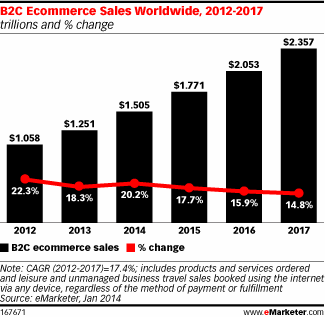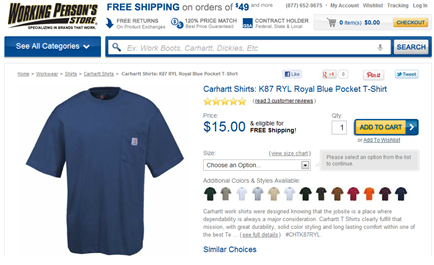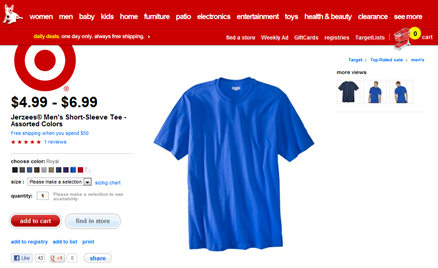
Imagine this.
Over $1.2 million are collectively spent on e-commerce sites from around the world every half minute. Desktop e-commerce sales generated a million dollars from that and over a quarter of a million came from mobile e-commerce sales. That’s how big e-commerce has become in recent years, and forecasts show these figures will continue to grow significantly in the next couple of years or so, reaching figures of more than $2.3 trillion by the year 2017.

E-commerce is big business that’s why tons of merchants jump into this bandwagon in the hopes of making big bucks from their listings and product showcases. However, success in e-commerce goes beyond merely posting hundreds or thousands of products from virtually any type or category onto your e-commerce website in a bid to get your site listed way up on search engine results.
SEO for e-commerce websites is different, and a bit more complicated, than blogs and other traditional websites. For one thing, products in these sites shuffle all the time and of top of this various other factors make it doubly hard for e-commerce sites to do SEO. This article presents some of the top e-commerce SEO problems online entrepreneurs may encounter from these sites – and the solutions that can help you deal with these problems and get the most from your e-commerce business.
1. Duplicate Content
One of the main factors that get websites penalized by search engines on ranking results is the occurrence of duplicate content. The nature and structure of e-commerce websites make it susceptible for the occurrence of duplicate content that will eventually affect its SEO performance.
The Problem:
Products in e-commerce sites are presented in categories and sub-categories that generate multiple URLs pointing to practically the same product page. Depending on how your e-commerce website is structured, ugly, and non-readable URLs are generated for each instance of a product page. If these instances get indexed by search engines, they will be treated as internal duplicate content or meta-data – which could get your website penalized in search results.
The Solution:
Here are tips and best practices that will help you deal with duplicate content:
- Areas that may create duplicate content such as category pages, sub-category pages, tags and archives can be excluded from indexing through the /robots.txt Robots Exclusion Protocol
- Reviews, comments and shopping carts in e-commerce sites usually create new URLs depending on how your website is structured. These pages as well as other duplicate pages generated can be excluded from being indexed by using the canonical tag or have only a single canonicalized version of the page at your website’s root
- New URLs generated that make links point to a seemingly duplicate content can be embedded with the nofollow attribute
2. Titles that Are Not Unique
Content is not the only area search engines look at to find duplicate content as they also do look at duplicated title tags, a problem online stores and e-commerce websites encounter as they grow larger in scale in particular. Identical values or non-unique titles can affect your SEO and search ranking results.
The Problem:
E-commerce deals with multiple products from different brands and in many cases several variations of the same products from the same brands. Each product variation are usually designated with its own product page that may have the same information, content, keywords and even title tags and elements. Title with similar tags and elements can be treated by search engines as duplicate content which could get your website potentially penalized from search rankings.
The Solution:
The following are tips and best practices that will help you deal with non-unique titles:
- Structure your title tags as: Brand – Model – Item Type, using unique model numbers that will make each title tag unique and stands out
- Instead of using single keywords in your title tag, use unique key phrases instead for each of your items. Use key phrases that your targeted customers will actually use when searching for the type of products you offer
- In your meta title descriptions, use the same unique key phrases on top of the item’s direct name
3. Poor URL Structure
Depending on how your e-commerce website is structured, particularly the CMS type you used to build your site, a default URL is generated for every product page produced and uploaded by your website. In many cases, the URLs generated are ugly (with too many extra characters with no semantic meaning) and not readable (using characters or plain numbers.
The Problem:
Default URLs generated by CMS applications used for e-commerce sites for each product page are usually not keyword-friendly or reader-friendly. Although these URLs make use of anonymous IDs or unique URL strings, they may not be readable from the perspective of search users, which can present a problem for you, now that search engines are focusing more on the semantics – or the meaning of words used in search terms – in ranking relevant websites for search results.
The Solution:
The tips and best practices presented below will help you deal with a poor URL structure:
- Make your URLs clean, short, easy to read and understand, and relevant to the product presented on the page
- Capitalization has a considerable impact on how search engines treat URLs so it would be best to stick to lower case letters in your URLs
- Instead of spaces or underscores in your URLs, use dashes instead
- Do not cannibalize the keywords in your URLs and make sure you use only relevant choice of keywords that will best describe the product
- Make your URLs short and is sufficient enough to let readers immediately understand what your site is all about just by looking at your URL
4. Not Optimized Product Pages
One of the key elements in e-commerce websites that will bring great results for your business is on how well you have crafted your product description and optimized your product pages. Just remember that you are optimizing your product pages for both targeted customers and search engines.
The Problem:
Search engine robots crawl websites to check for relevant information that they can match with search queries. Without good information, search engines will have no way of knowing what your website is all about and will of course not rank you in search results related to the products you are selling in your e-commerce websites.
Many e-commerce sites make the mistake of posting only pictures of the products, short title and the price of the product. However, search engine robots do not look at images in the same manner as people do – and would depend on other information that will help them index your pages for future search queries.
The Solution:
Presented below are some tips and best practices that will help you optimize your product pages:
- Use keywords based on what your targeted audiences use for searching for the type of products you present in your e-commerce website. Do not over-optimize your pages with keywords however, such as repeatedly using these keywords all throughout the page
- Category pages are better presented with good introductory content for both SEO and providing value to search users. Make use of descriptive and informative text that will tell audiences what your pages are all about
- Avoid using standard product descriptions that come from the manufacturers (which in many cases are done in poorly written English) or duplicate those found from other e-commerce websites
- Add more detailed information that targeted users may be looking for like how the products were made, raw materials used, unique features, and other information that targeted readers may find relevant and interesting
- Make sure product description is uploaded to the product page itself and not through i-frames which will function poorly from an SEO perspective
5. Product Variations
Many products come in different variations that are basic to their designs such as sizes and colors. In many cases, each variation is designated with its own page – which will create some issues for you from an SEO perspective.
The Problem:
Variations of a product occur if there are more than one style, size, or color. Depending on your website structure, each variation may have its own page which will be treated by the search engines as duplicate content, thus affecting SEO. Take this example from WorkingPerson.com which presented different pages for every color variation.

The page above samples the product using a particular color and a new page is created. A variation of the product existed, this time using a different color, and another product page is generated for that particular color. Having multiple pages will not only put your site into trouble because of duplicate content, it will also drive your link equity thin as it becomes spread out on all variation pages – which will not bode well for your SEO efforts.

The Solution:
To avoid duplicate content whenever someone looks at a color variation of the same product, it would be best to maintain a single page for every product where all information can be accessed, including color variations which can be best viewed not as a separate page but through JavaScript application – just like what Target makes use on their site.

6. Homepage Redirects
Ideally, the Homepage button should bring you back to the root of your website, the starting point from which all other pages and content can be launched from. However, many e-commerce sites are structured that redirects homepage references not to the main root but to another page.
The Problem:
The main problem with homepage redirects is that your website will end up with link equity getting diluted, affecting your SEO performance. This is because link equity will be subdivided into the root page and the homepage redirects as well. Aside from homepage links, another practice seen that will dilute link equity is the improper link designations to the header logo – which should redirect to the homepage – and not to another page.
The Solution:
Homepage redirects to another page other than the root page may have been caused by the type of CMS you used for your site, particularly if it used session ID’s when generating URLs for each page. Make sure you change the default to unique title structures and check each of your page links if they point to the right pages in your websites.
7. Image ALT Tags
As mentioned earlier, search engines have no way of viewing images unless proper descriptive information that tells what the image is all about is incorporated into the image ALT tags.
The Problem:
Without knowing how to categorize an image, the page will not be properly indexed and ranked by the search engines. This will present a big impact on your website’s SEO, which can be compounded further as more products – and images as well – are added into your listings.
The Solution:
Include proper descriptive information with your Image ALT Tags, including proper keyword phrases as well as other information that will help search engines know what the image is all about, and search users rely on when searching for images about a particular product or brand.
8. Lack of Product Reviews
As a Business-2-Customer set-up, most e-commerce sites are structure with its own product review and grading system, which can help boost your SEO.
The Problem:
Online users rely heavily on the opinion of others before them and would first search for similar information before they decide on purchasing a product. Many rely on what others have to say and will rely on what previous buyers say through reviews and comments about the product. Reviews are also important from an SEO perspective, now that search engines continuously improve on search algorithms that will make search more semantic, consumer-centric, and social.
The Solution:
It would be best to integrate a good review app and system with your e-commerce website where buyers can easily place their reviews on products they purchased or viewed. The system should be easy for them to use and get access to, so make sure the system is ready before you ask or encourage targeted customers to pitch in their reviews and feedback.
Maintaining a successful e-commerce website and business is a great way for earning substantial income online. However, doing so is not as simple as listing products or putting up a website with a built-in shopping cart system. Success depends on how well you structure your website, how easy it is for online users to navigate and use – and how effective you deal with common SEO problems e-commerce websites encounter.
Jomer B. Gregorio is a well-rounded expert when it comes digital marketing. Jomer is also known as a semantic SEO evangelist and practitioner. Check out our Digital Marketing Services today and let us help you in achieving positive and profitable results for your business.
